Effects of V Addition on the Deformation Mechanism and Mechanical Properties of Non-Equiatomic CoCrNi Medium-Entropy Alloys
Abstract
:1. Introduction
2. Materials and Methods
3. Results
3.1. Microstructure of the Annealed Specimen
3.2. Mechanical Properties
3.3. Microstructure after Tensile Tests
4. Discussion
4.1. Effect of V Addition on the SFE and Lattice Distortion
4.2. Non-Monotonic Change of the Strain-Hardening Behavior with V Addition
5. Conclusions
- Singe-phase FCC CoCrNiV alloys with different V additions were obtained after solid solution treatment.
- The plastic deformation of 2V alloy is dominated by dislocation slip, SFs, and HCP martensitic transformation. With increasing the V content, the SFE of CoCrNiV alloy increases, and dislocation slip and SFs prevail in 6V and 10V alloys.
- The strain-hardening behavior changes non-monotonically with increasing the V content. The lower strain-hardening rate of 6V alloy than that of 2V alloy is dominated by the SFE. The higher strain-hardening rate of 10V alloy than that of 6V alloy is dominated by the lattice distortion.
Author Contributions
Funding
Institutional Review Board Statement
Informed Consent Statement
Data Availability Statement
Conflicts of Interest
References
- Wagner, C.; Laplanche, G. Effects of stacking fault energy and temperature on grain boundary strengthening, intrinsic lattice strength and deformation mechanisms in CrMnFeCoNi high-entropy alloys with different Cr/Ni ratios. Acta Mater. 2023, 244, 118541. [Google Scholar] [CrossRef]
- Jabeen, N.; Hussain, A.; Qaiser, M.A.; Ali, J.; Rehman, A.; Sfina, N.; Ali, G.A.; Tirth, V. Enhanced Energy Storage Performance by Relaxor Highly Entropic (Ba0.2Na0.2K0.2La0.2Bi0.2)TiO3 and (Ba0.2Na0.2K0.2Mg0.2Bi0.2)TiO3 Ferroelectric Ceramics. Appl. Sci. 2022, 12, 12933. [Google Scholar] [CrossRef]
- Fan, R.; Zhao, S.; Wang, L.; Wang, L.; Guo, E. Effect of Annealing Temperature on the Microstructure and Mechanical Properties of CoCrFeNiNb0.2Mo0.2 High Entropy Alloy. Materials 2023, 16, 3987. [Google Scholar] [CrossRef] [PubMed]
- Zhang, X.; Yang, D.; Jia, Y.; Wang, G. Microstructure and Nanoindentation Behavior of FeCoNiAlTi High-Entropy Alloy-Reinforced 316L Stainless Steel Composite Fabricated by Selective Laser Melting. Materials 2023, 16, 2022. [Google Scholar] [CrossRef] [PubMed]
- Wang, Y.; Li, D.; Yang, J.; Jin, J.; Zhang, M.; Wang, X.; Li, B.; Hu, Z.; Gong, P. Effect of Grain Size on the Tribological Behavior of CoCrFeMnNi High Entropy Alloy. Materials 2023, 16, 1714. [Google Scholar] [CrossRef]
- Yi, H.; Xie, R.; Zhang, Y.; Wang, L.; Tan, M.; Li, T.; Wei, D. Tuning Microstructure and Mechanical Performance of a Co-Rich Transformation-Induced Plasticity High Entropy Alloy. Materials 2022, 15, 4611. [Google Scholar] [CrossRef]
- Rémy, L.; Pineau, A. Twinning and strain-induced f.c.c.→h.c.p. transformation on the mechanical properties of Co-Ni-Cr-Mo alloys. Mater. Sci. Eng. 1976, 26, 123–132. [Google Scholar] [CrossRef]
- Laplanche, G.; Kostka, A.; Reinhart, C.; Hunfeld, J.; Eggeler, G.; George, E.P. Reasons for the superior mechanical properties of medium-entropy CrCoNi compared to high-entropy CrMnFeCoNi. Acta Mater. 2017, 128, 292–303. [Google Scholar] [CrossRef]
- Huang, D.; Zhuang, Y. Break the strength-ductility trade-off in a transformation-induced plasticity high-entropy alloy reinforced with precipitation strengthening. J. Mater. Sci. Technol. 2022, 108, 125–132. [Google Scholar] [CrossRef]
- Tian, Y.Z.; Zhao, L.J.; Chen, S.; Shibata, A.; Zhang, Z.F.; Tsuji, N. Significant contribution of stacking faults to the strain hardening behavior of Cu-15%Al alloy with different grain sizes. Sci. Rep. 2015, 5, 16707. [Google Scholar] [CrossRef] [Green Version]
- Mustafa, F.; Egilmez, M.; Abuzaid, W.; El-Khatib, S.; Nawaz, T.; Ahmad, S.; Alagoz, S. Strange Metallicity and Magnetic Order in the CoNi(Cr/V) Medium-Entropy Alloy System. Materials 2023, 16, 1044. [Google Scholar] [CrossRef] [PubMed]
- Miao, J.; Slone, C.E.; Smith, T.M.; Niu, C.; Bei, H.; Ghazisaeidi, M.; Pharr, G.M.; Mills, M.J. The evolution of the deformation substructure in a Ni-Co-Cr equiatomic solid solution alloy. Acta Mater. 2017, 132, 35–48. [Google Scholar] [CrossRef]
- Li, Z.T.; Ma, S.H.; Zhao, S.J.; Zhang, W.D.; Peng, F.; Li, Q.; Yang, T.; Wu, C.-Y.; Wei, D.X.; Chou, Y.-C.; et al. Achieving superb strength in single-phase FCC alloys via maximizing volume misfit. Mater. Today 2023, 63, 108–119. [Google Scholar] [CrossRef]
- Sohn, S.S.; Kwiatkowski da Silva, A.; Ikeda, Y.; Körmann, F.; Lu, W.; Choi, W.S.; Gault, B.; Ponge, D.; Neugebauer, J.; Raabe, D. Ultrastrong Medium-Entropy Single-Phase Alloys Designed via Severe Lattice Distortion. Adv. Mater. 2019, 31, 1807142. [Google Scholar] [CrossRef] [Green Version]
- Yin, B.; Maresca, F.; Curtin, W.A. Vanadium is an optimal element for strengthening in both fcc and bcc high-entropy alloys. Acta Mater. 2020, 188, 486–491. [Google Scholar] [CrossRef]
- Oh, H.S.; Kim, S.J.; Odbadrakh, K.; Ryu, W.H.; Yoon, K.N.; Mu, S.; Körmann, F.; Ikeda, Y.; Tasan, C.C.; Raabe, D.; et al. Engineering atomic-level complexity in high-entropy and complex concentrated alloys. Nat. Commun. 2019, 10, 2090. [Google Scholar] [CrossRef] [PubMed] [Green Version]
- Yoshida, S.; Ikeuchi, T.; Bhattacharjee, T.; Bai, Y.; Shibata, A.; Tsuji, N. Effect of elemental combination on friction stress and Hall-Petch relationship in face-centered cubic high/medium entropy alloys. Acta Mater. 2019, 171, 201–215. [Google Scholar] [CrossRef]
- Tu, J.; Yang, W.; Xu, K.; Zhou, Z.; Dou, Y.; Wang, Y. Effect of Ta content on stacking fault energy and microstructure characteristics of (VCoNi)100-XTaX (X = 0, 0.05, 0.5 and 1) medium entropy alloy. Mater. Lett. 2021, 305, 130770. [Google Scholar] [CrossRef]
- Gu, Z.J.; Tian, Y.Z.; Xu, W.; Lu, S.; Shang, X.L.; Wang, J.W.; Qin, G.W. Optimizing transformation-induced plasticity in CoCrNi alloys by combined grain refinement and chemical tuning. Scr. Mater. 2022, 214, 114658. [Google Scholar] [CrossRef]
- Liu, D.; Yu, Q.; Kabra, S.; Jiang, M.; Forna-Kreutzer, P.; Zhang, R.; Payne, M.; Walsh, F.; Gludovatz, B.; Asta, M.; et al. Exceptional fracture toughness of CrCoNi-based medium- and high-entropy alloys at 20 kelvin. Science 2022, 378, 978–983. [Google Scholar] [CrossRef]
- Zhang, Y.J.; Han, D.; Li, X.W. A unique two-stage strength-ductility match in low solid-solution hardening Ni-Cr alloys: Decisive role of short range ordering. Scr. Mater. 2020, 178, 269–273. [Google Scholar] [CrossRef]
- Gong, D.; Cao, Y.; Deng, X.; Jiang, L. Higher proportional limit of SiC/Al composites with nano-scaled stacking faults. Compos. Commun. 2022, 32, 101188. [Google Scholar] [CrossRef]
- Cottrell, A.H. Theory of dislocations. Prog. Met. Phys. 1949, 1, 77–126. [Google Scholar] [CrossRef]
- Chen, Z.; Xie, H.; Yan, H.; Pang, X.; Wang, Y.; Wu, G.; Zhang, L.; Tang, H.; Gao, B.; Yang, B.; et al. Towards ultrastrong and ductile medium-entropy alloy through dual-phase ultrafine-grained architecture. J. Mater. Sci. Technol. 2022, 126, 228–236. [Google Scholar] [CrossRef]
- Jo, Y.H.; Jung, S.; Choi, W.M.; Sohn, S.S.; Kim, H.S.; Lee, B.J.; Kim, N.J.; Lee, S. Cryogenic strength improvement by utilizing room-temperature deformation twinning in a partially recrystallized VCrMnFeCoNi high-entropy alloy. Nat. Commun. 2017, 8, 15719. [Google Scholar] [CrossRef] [Green Version]
- Okamoto, N.L.; Yuge, K.; Tanaka, K.; Inui, H.; George, E.P. Atomic displacement in the CrMnFeCoNi high-entropy alloy—A scaling factor to predict solid solution strengthening. AIP Adv. 2016, 6, 125008. [Google Scholar] [CrossRef]
- Bajpai, S.; MacDonald, B.E.; Rupert, T.J.; Hahn, H.; Lavernia, E.J.; Apelian, D. Recent progress in the CoCrNi alloy system. Materialia 2022, 24, 101476. [Google Scholar] [CrossRef]
- De Cooman, B.; Estrin, Y.; Kim, S. Twinning-induced plasticity (TWIP) steels. Acta Mater. 2018, 142, 283–362. [Google Scholar] [CrossRef]
- Kalsar, R.; Khandal, P.; Suwas, S. Effects of Stacking Fault Energy on Deformation Mechanisms in Al-Added Medium Mn TWIP Steel. Metall. Mater. Trans. A 2019, 50, 3683–3696. [Google Scholar] [CrossRef]
- Slone, C.E.; Miao, J.; George, E.P.; Mills, M.J. Achieving ultra-high strength and ductility in equiatomic CrCoNi with partially recrystallized microstructures. Acta Mater. 2019, 165, 496–507. [Google Scholar] [CrossRef]
- An, X.L.; Ni, S.; Song, M.; Liao, X.Z. Deformation Twinning and detwinning in face-centred cubic metallic materials. Adv. Eng. Mater. 2020, 22, 1900479. [Google Scholar] [CrossRef]
- Tian, Y.Z.; Peng, S.Y.; Chen, S.F.; Gu, Z.J.; Yang, Y.; Shang, X.L.; Deng, G.Y.; Su, L.H.; Sun, S.J. Temperature-dependent tensile properties of ultrafine-grained C-doped CoCrFeMnNi high-entropy alloy. Rare Met. 2022, 41, 2877–2885. [Google Scholar] [CrossRef]
- Lee, C.-F.; Shun, T.-T. Effects of the Replacement of Co with Ni on the Microstructure, Mechanical Properties, and Age Hardening of AlCo1−xCrFeNi1+x High-Entropy Alloys. Materials 2021, 14, 2665. [Google Scholar] [CrossRef] [PubMed]


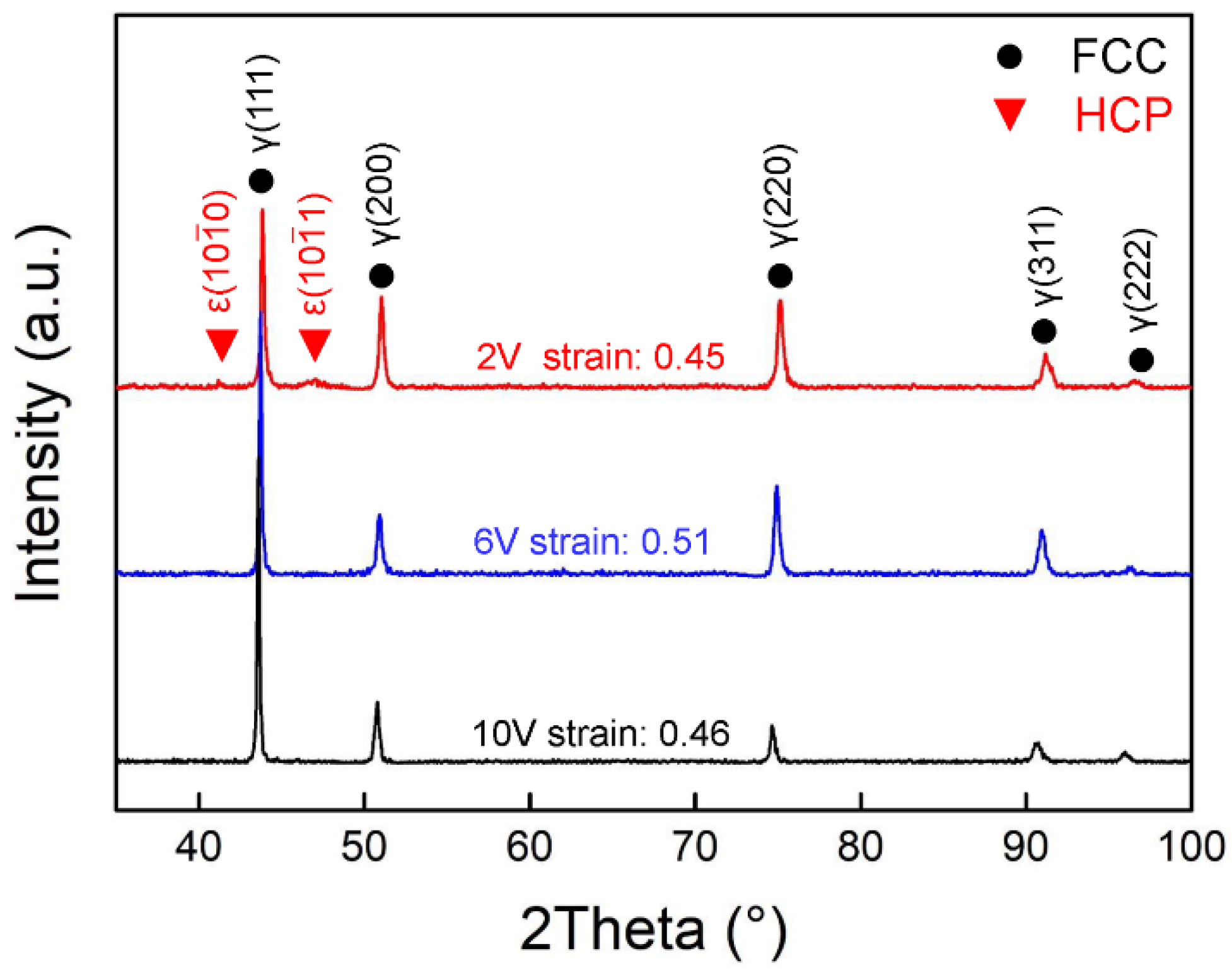
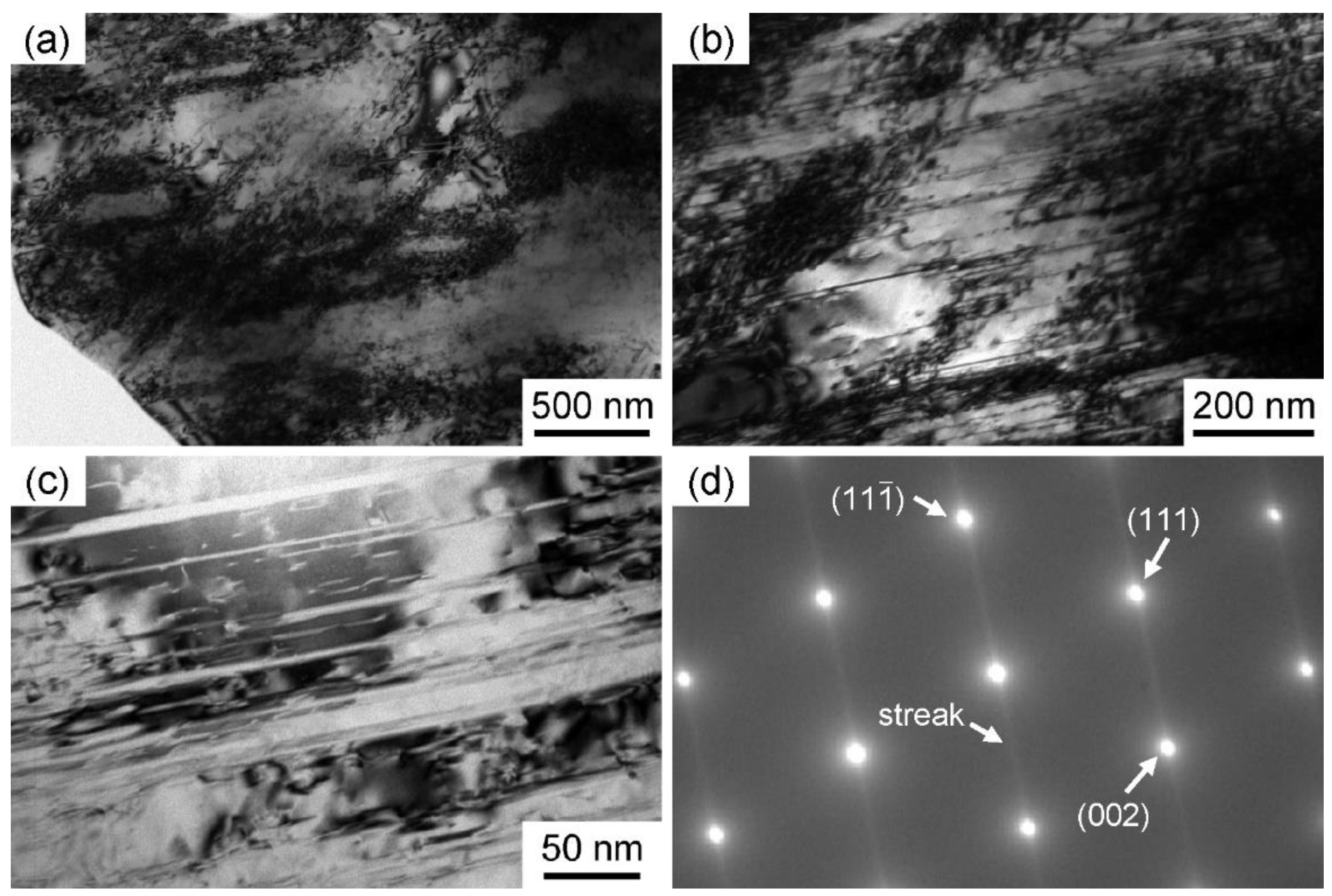
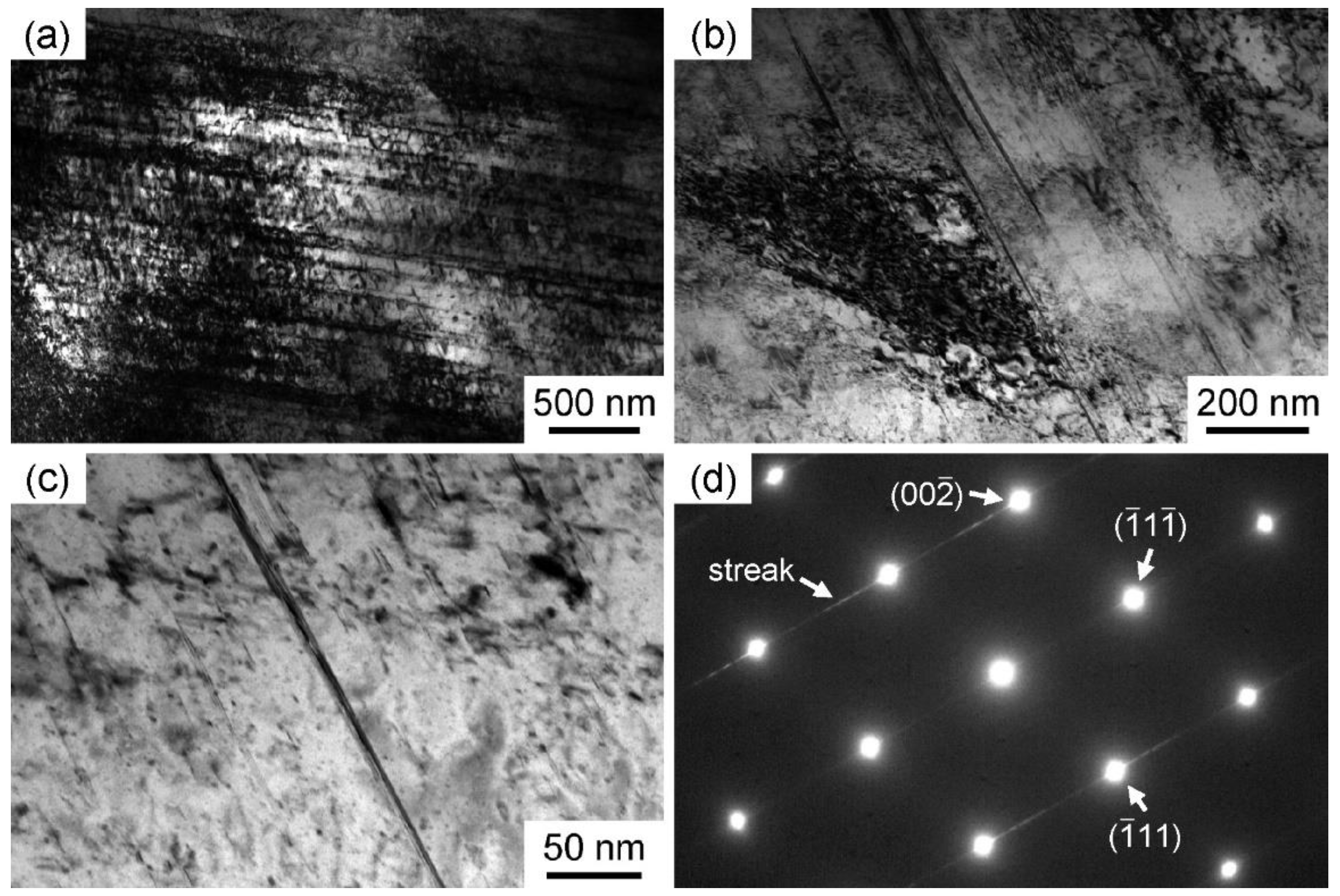
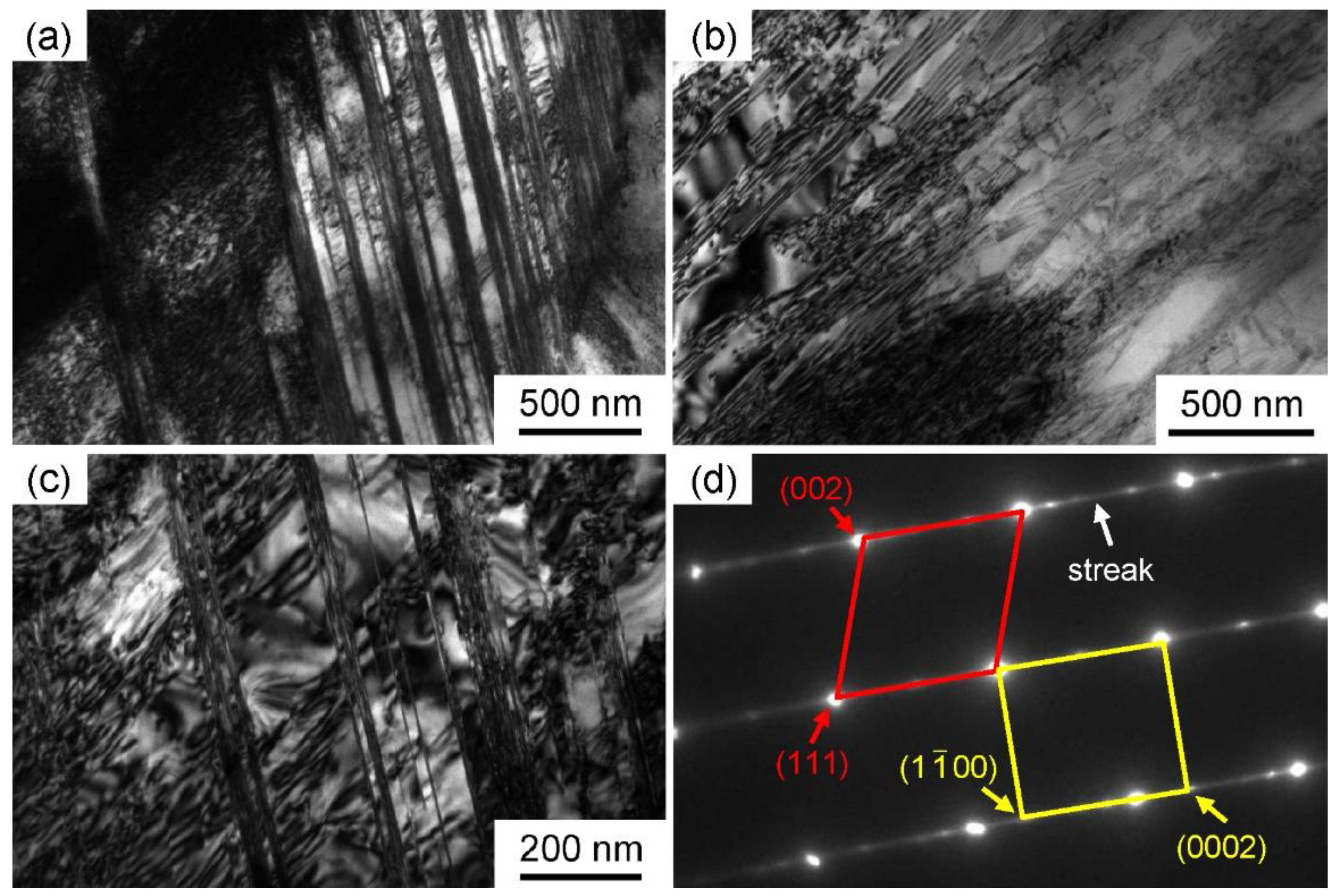
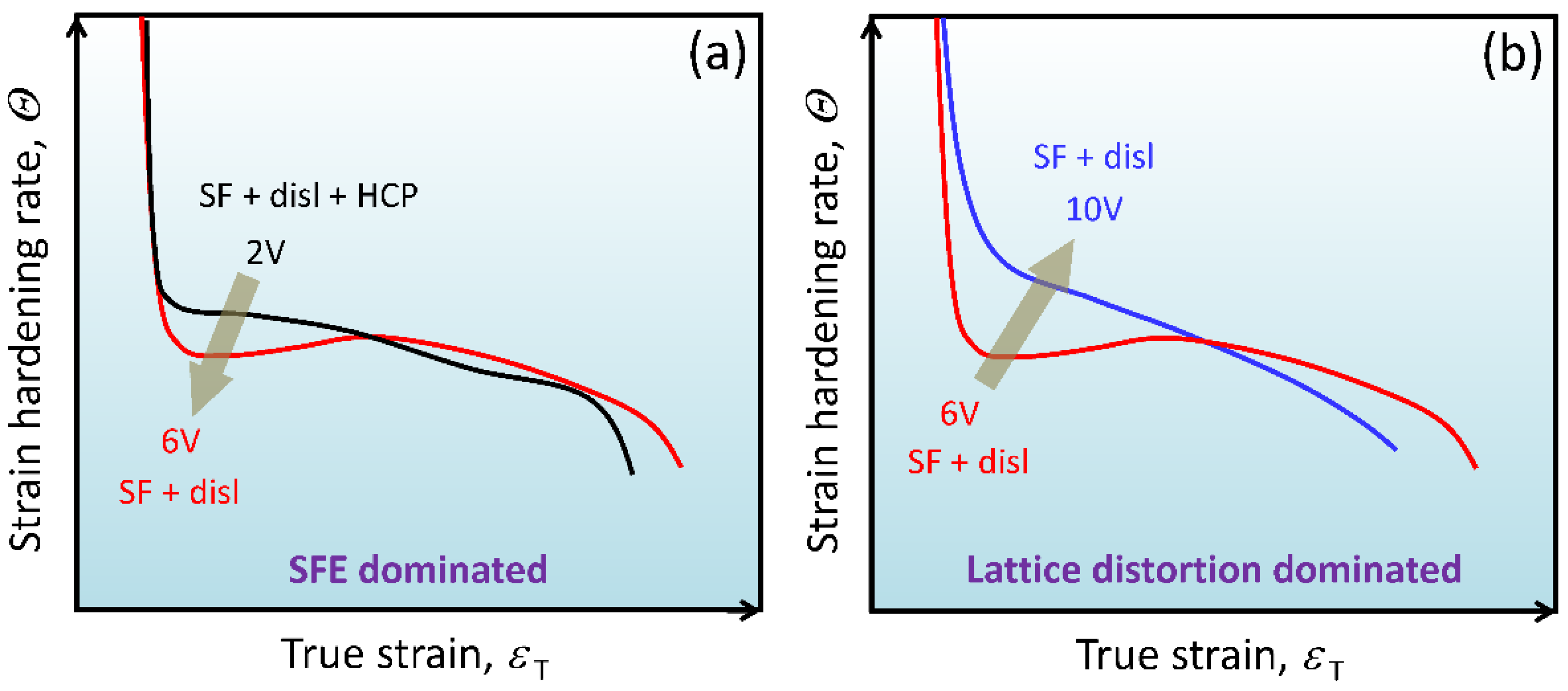
Disclaimer/Publisher’s Note: The statements, opinions and data contained in all publications are solely those of the individual author(s) and contributor(s) and not of MDPI and/or the editor(s). MDPI and/or the editor(s) disclaim responsibility for any injury to people or property resulting from any ideas, methods, instructions or products referred to in the content. |
© 2023 by the authors. Licensee MDPI, Basel, Switzerland. This article is an open access article distributed under the terms and conditions of the Creative Commons Attribution (CC BY) license (https://creativecommons.org/licenses/by/4.0/).
Share and Cite
Shen, R.; Ni, Z.; Peng, S.; Yan, H.; Tian, Y. Effects of V Addition on the Deformation Mechanism and Mechanical Properties of Non-Equiatomic CoCrNi Medium-Entropy Alloys. Materials 2023, 16, 5167. https://doi.org/10.3390/ma16145167
Shen R, Ni Z, Peng S, Yan H, Tian Y. Effects of V Addition on the Deformation Mechanism and Mechanical Properties of Non-Equiatomic CoCrNi Medium-Entropy Alloys. Materials. 2023; 16(14):5167. https://doi.org/10.3390/ma16145167
Chicago/Turabian StyleShen, Rui, Zengyu Ni, Siyuan Peng, Haile Yan, and Yanzhong Tian. 2023. "Effects of V Addition on the Deformation Mechanism and Mechanical Properties of Non-Equiatomic CoCrNi Medium-Entropy Alloys" Materials 16, no. 14: 5167. https://doi.org/10.3390/ma16145167









